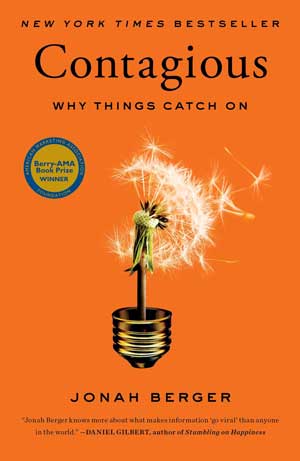In Contagious: Why Things Catch On, Jonah Burger lays out his research on why some content goes viral and other content does not.
Triggers
Clever ads may get people talking in the short term. But what goes people talking in the long term? Burger argues you need a trigger.
For example, we’ve all taken the piss out of Rebecca Black’s song “Friday”. And Burger goes, too. But he also notes that it gets an incredible amount of views. Almost all of which happen on one day each week. Can you guess which one?
What is going on here? Once a week, it’s Friday. And it being Friday triggers your memory of how awful the song was. And you go watch it on YouTube.
This triggering is going on all over the place. For example, where you vote (school, church, etc.) affects how you vote.
Good advertising campaigns take advantage of this, too. For example “Have a break, have a KitKat”. Every time you have a break… Or Budweiser’s “what’s up” every time you answer the phone.
It needs to be something you run into commonly. For example, using a holiday as a trigger would be a bad idea because it comes around only once a year. Using the weekend as a trigger: much better.
It also needs to arrive at a relevant time. For example, a public service message about the importance of bathmats that shows someone slipping is of little use. Why? Because you can’t buy a bathmat when you step out of the shower. They need to slip when they are in a Bed, Bath & Beyond store.
Grow your environment
You can make your market larger, with the right message. For example, Boston Chicken. They could run an advert that said:
“Thinking about chicken? Think Boston Chicken.”
Fine. It might well capture a lot of the market for people looking for chicken. But how about:
“Thinking about dinner? Think Boston Chicken.”
Now you have cued people to think about Boston Chicken for dinner every time they drive home. Much better.
Emotion
In general, positive messages work better than negative ones. However, the situation is more complex than that. People share stories that are high arousal. This can be both positive and negative.
For example, awe and delight cause sharing. If something is amazing or really funny, you are far more likely to share it. Whereas contentment and sadness are low arousal emotions: they don’t inspire you to do anything.
On the negative side, there are two emotions that do promote arousal: anxiety and anger.
What is interesting about arousal is that you can artificially create it. If you have people do moderate exercise or jump up and down, and then look at their Facebook feed, they are more likely to share stories.
Social proof
People like to do what other people do. This is most evident in bad public service messages. “Say No To Drugs”, for example, reinforced the message that drug use was common and that all the cool kids were doing it.
Similarly, using the slogan “only 37% of people pay for music” encourages people to steal music because they feel like an idiot for buying it when everyone else is getting it from Napster.
“When people are free to do as they please, they usually imitate each other.”
In the case of products, they need to be publicly visible to catch on. Toothpaste doesn’t usually go viral, for example. Whereas Apple’s iconic headphones did because everyone could see other people wearing them.
Practical value
People love to share things that provide practical value. Why? Association. They look smarter by sharing useful knowledge with other people. It gives them social currency.
While a silly meme may get traction in the short-term, a brilliant how-to will get milage for a long time because people will see the value in it and keep sharing.
Harnessing the value for your brand
To get value out of viral content [as a business], you need to make your brand integral to the story. For example, Golden Casino or whatever they are called sponsor a lot of stuff. But you can tell a story about someone buying a jar of air without mentioning their brand.
Contrast that with Will It Blend. We share this because it’s awe-inspiring to see a blender crush up iPhones, lighters and marbles. But, critically, you can’t tell the story without talking out the blender. And Blendtec benefits.

Don't have time to check my blog? Get a weekly email with all the new posts. This is my personal blog, so obviously it is 100% spam free.
Tags: marketing, viral marketing
This entry was posted on Tuesday, May 16th, 2017 at 11:00 am and is filed under Books. You can follow any responses to this entry through the RSS 2.0 feed. Both comments and pings are currently closed.
